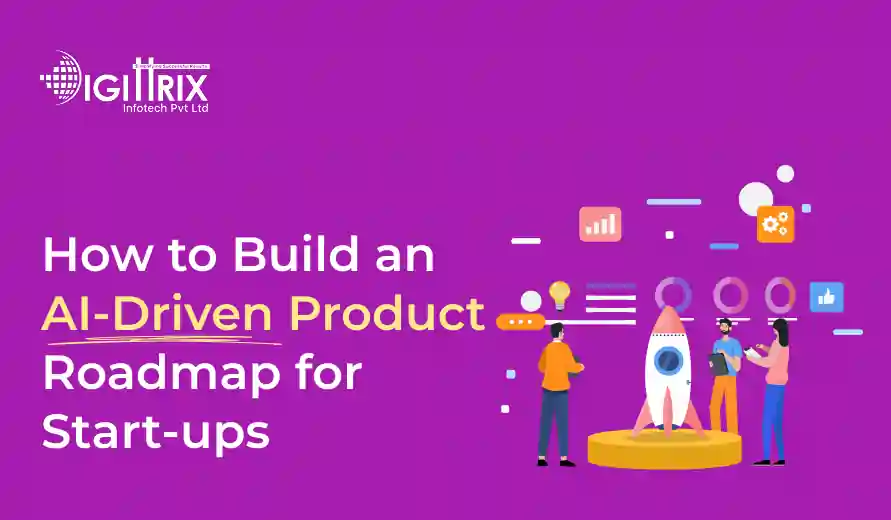Startups leveraging AI-driven product roadmaps realize quicker feature releases, increased user satisfaction, improved resource use, and data-based decisions that reduce risks and enhance project planning.
Highlights
With Over 14 years of Experience in the IT Field, Helping Companies Optimise there Products for more Conversions

Creating a product roadmap is a vital step for any startup. A roadmap helps define the vision, align teams, prioritize tasks, and monitor progress. With the rise of artificial intelligence (AI), startups can now build AI-powered product roadmaps that are not only based on data but also predictive. This enables founders and teams to make smarter decisions, reduce guesswork, and streamline the overall development process.
In this article, we will explain step by step how startups can create an AI-driven product roadmap, the advantages of using AI in planning, and practical tips for implementation.
Want to boost your marketing with AI? Read Digittrix’s guide to using AI in marketing for practical use cases, benefits, and ROI tips!
Before exploring AI-driven solutions, it’s crucial to understand what a product roadmap truly is. A product roadmap is a strategic plan that details the goals, milestones, features, and timeline for a product’s development. For startups, roadmaps act as a blueprint that aligns all stakeholders, including product managers, developers, designers, and marketing teams.
Traditionally, roadmaps were made manually, relying on intuition and market experience. While this approach can work, it often overlooks critical insights that data can reveal. This is where AI can be highly valuable.
AI can analyze large amounts of data, recognize patterns, and predict outcomes with high precision. When used in product planning, AI can:
By integrating AI into the roadmap process, startups can make better-informed, more precise, and data-driven decisions.
The first step in creating any roadmap is to clearly define the product vision. What problem does your startup address? What makes your product stand out? Your roadmap should align with your startup's long-term goals, providing a clear direction for development.
Next, establish measurable goals. For example, if you're focusing on mobile app development, your goals could include increasing app downloads, boosting user retention, or adding specific features for your target audience. Setting clear objectives from the start will help AI tools analyze data more effectively and deliver actionable insights.
AI-driven roadmaps depend heavily on data. Begin by collecting data from various sources:
Once collected, use AI tools to analyze the data. For example, machine learning algorithms can pinpoint which features users request most often or which functions are underperforming. This helps startups understand what the market values, which is crucial when setting priorities for a product roadmap.
An AI-driven roadmap should consider the diversity of your user base. Segment users based on their behavior, preferences, and demographics. AI can group users into distinct segments, helping startups understand which features will attract which audience.
Creating user personas helps ensure every product decision aligns with real user needs. For startups offering on-demand or custom app development services, understanding these segments is essential. AI can detect patterns and suggest personas automatically, saving time and increasing accuracy.
One of the hardest parts of product development is choosing which features to build first. AI can assist in prioritizing features based on various factors, such as:
By scoring and ranking features, startups can make informed decisions about what to include in the initial product launch versus what can be added later. This step is especially helpful for startups planning mobile app development or on-demand app development, where delivering key features on time can influence user adoption.
AI can estimate the time needed to develop each feature by analyzing historical project data, developer performance, and complexity levels. Predictive analytics helps startups create realistic schedules and avoid over-promising on deadlines.
For example, an AI system might suggest that a specific feature will take 3 weeks to develop, while another could require 5 weeks due to its complexity. By incorporating these insights into the roadmap, startups can make sure project timelines are realistic and resources are used efficiently.
Efficient resource allocation is crucial for startups that often have limited budgets. AI can suggest how to assign team members, budgets, and tools based on feature priorities and schedules.
For example, if your startup collaborates with an app development company, AI can recommend which developers should focus on specific features based on their skills and past performance. This method reduces bottlenecks and boosts productivity.
An AI-driven roadmap is flexible. The market shifts, customer preferences change, and development issues can occur. AI systems can keep track of progress and offer real-time advice to adjust priorities.
This ongoing feedback loop helps startups stay flexible and respond quickly to changes. For example, if users are consistently requesting a new feature in your mobile app development project, AI can highlight this demand so it can be prioritized on the roadmap.
Visualization plays a crucial role in conveying your product roadmap to stakeholders. AI tools can automatically produce clear, interactive visuals that display timelines, feature priorities, and progress.
For startups offering custom app development services, sharing a well-visualized roadmap with clients can enhance transparency and foster trust. Visualization tools help teams and stakeholders stay aligned and understand the reasoning behind each decision.
To make the AI-driven roadmap actionable, connect it with project management tools like Jira, Trello, or Asana. This ensures that AI insights are directly turned into tasks, milestones, and deadlines.
For instance, an AI-prioritized feature can automatically be added to a Jira sprint with estimated timelines and assigned resources. This reduces manual work and allows the team to focus on building the product.
Finally, the roadmap should be viewed as a living document. Continuously gather feedback from users, team members, and stakeholders. AI can assist in analyzing this feedback to update the roadmap, reprioritize features, or propose improvements.
For startups in mobile app development, this is especially important because user expectations change quickly. Regularly updating the roadmap keeps the product relevant and aligned with user demands.
Creating a product roadmap using AI offers several advantages:
Startups that leverage AI for on-demand app development or collaborate with an app development company can gain a significant competitive edge through smarter planning and execution.
Multiple AI tools can assist startups in developing and managing product roadmaps.
These tools make it easier for startups to use AI without needing deep technical skills.
Following these tips guarantees a smooth AI adoption and delivers real benefits to your startup.
Discover how AI is transforming learning—read Digittrix’s guide on AI in education apps to explore real-world use cases and advantages.
Creating an AI-driven product roadmap is essential for startups aiming to succeed in a competitive market. By leveraging AI’s predictive capabilities with clear strategic planning, startups can develop roadmaps that are data-driven, adaptable, and actionable.
The process includes defining a product vision, collecting and analyzing data, segmenting users, prioritizing features, estimating timelines, allocating resources, visualizing the roadmap, integrating with project management tools, and continuously refining the plan.
For startups involved in mobile app development, on-demand app creation, or offering custom app development services, an AI-driven roadmap helps ensure projects are completed on time, meet user expectations, and use resources efficiently. Working with an experienced app development firm while using AI in planning can further accelerate success.
By following the steps in this guide, startups can develop AI-driven roadmaps that not only guide development but also clearly define how to achieve business goals. Proper use of AI leads to better decision-making, reduces risk, and focuses on delivering value to users.
Artificial Intelligence (AI) is aiding startups and businesses in planning, developing, and delivering products more efficiently. From analyzing customer preferences to predicting market trends, AI supports smarter decision-making and more targeted product development.
At Digittrix, we work with startups and businesses to create AI-driven product roadmaps that guide mobile apps, websites, and custom software. Whether you’re prioritizing features, simplifying development schedules, or partnering with an app development firm, our team can help implement practical AI solutions tailored to your goals.
If you're interested in how AI can enhance your product planning and speed up development, reach out to our experienced team today. Call +91 8727000867 or email digittrix@gmail.com to discuss how AI can effectively support your product strategy and roadmap.

Do you need help in ?




Join over 1500+ businesses we've already helped!
It is a roadmap that uses artificial intelligence to analyze data, predict trends, and help startups plan and prioritize product development effectively.
AI helps startups make informed decisions, reduce risks, allocate resources wisely, and focus on features that meet user needs.
AI can analyze trends, predict user preferences, estimate timelines, and suggest which features should be prioritized.
Yes, AI continuously analyzes data and provides recommendations to adjust the roadmap according to evolving user needs and market changes.

©2025Digittrix Infotech Private Limited , All rights reserved.